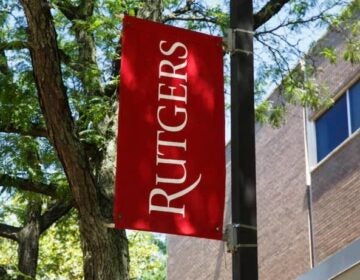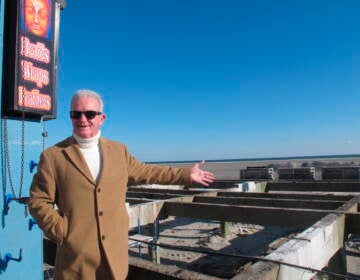After one year, renovations to Camden County’s primary park ready for next step
One year into a major overhaul that could take up to a decade, Camden County officials are preparing to start the most visible and significant phase of their $23 million renovation of Cooper River Park, which stretches into parts of Cherry Hill, Haddon Township, Collingswood and Pennsauken.
After spending approximately 11 months and $230,000 to construct eye-pleasing berms, add signage and plant flowers at two eastern entrances to the park, the county is planning to break ground this fall on projects that include and encircle the Jack Curtis Stadium and its surrounding playground and concert grounds.
County parks director Frank Moran calls the stadium the “focal point of the park,” and Dan Keashen, director of communications, explains why: “It’s really where Camden County meets. If you have a hobby in just about anything you’re going to meet there at some point.”
Bringing people closer to the river
Phase 1B, as they’re unofficially calling the as-yet unfinalized second stage of the project, should bring the rehabbing of the stadium and a reconfiguration of its track. They also anticipate laying a one-mile paved walkway along the river to connect the stadium area on the park’s north side to the eastern end – filled every weekend from spring to late fall with rowers and spectators who converge from around the country to participate in nationally ranked high school, college and masters regattas.
“With the amount of pedestrian and bike traffic through the park, this gives individuals a more scenic way to access the stadium and the staging areas for the regattas,” said Moran.
Adds Keashen, “You’ll remember that the whole concept of the renovation is trying to deliver the river to the residents. The path really does that.”
Save one walkway that wraps itself around tiny Veteran’s Island (behind The Lobster Trap restaurant), there is currently no paved trail that abuts the river; bikers and runners must instead stick to a cement lane that presses hard against the road, lying hundreds of yards from the body of water that gives the park its name.
Though maintenance crews have focused on opening up visual access to this part of the river by trimming the trees and bushes that long blocked its views, there’s still almost no place to access or engage with it. And that’s why the third main component to the upcoming $5 million phase is the construction of a deck near the finish line to the crew races. Not only will it provide a comfortable setting from which to watch the rowers, it will also give waterside refuge to readers, picnickers and anglers fishing for carp, bass and perch.
Other improvement projects nearby
It’s expected these improvements will take approximately 18 months and complement other work being done: Haddon Township is beautifying Cuthbert Boulevard, which runs atop the regatta staging area, and better connecting it with the park below; and the state is financing a three-year project to widen the Route 130 bridge and make it a safer place for bikers and walkers to cross into the western portion of CRP.
Phase 1B should also wrap up around the same time as another ($4 million) county project to dredge the river to counteract the effects of non-point source pollution and sediment caused by erosion. Years of runoff has made the water’s edge so shallow that dismayed rowers call one of their racing lanes “the dead zone.”
Freeholder liaison to the parks department Jeff Nash considers this the most important facet of the park project, even though technically it’s separate. “In my view, the most important progress in our park is the deepening of the river to allow regattas to continue. They contribute so much to the local economy,” he said.
They contribute $10 million per year, to be precise, and county leaders feel it’s past time to spend money to protect that source of revenue and perhaps even augment it. After they complete Phase 1B, they intend to replace port-o-pots with a permanent brick restroom near the stadium, and they anticipate enhancing the approach to the boathouse – home to formal functions like weddings – by encouraging the growth of adjacent wetlands and building an elevated wooden walkway to guide visitors through the natural landscape as they travel from the stadium parking lot to the boathouse entrance.
The Cooper River in Camden
As work on the park gains momentum, progress is also being made on one long-standing point of contention: adjoining riverfront land that runs through the city of Camden. For more than a decade, the Delaware River Port Authority (DRPA) has promised to transfer the neglected woodlands to the county for activation and maintenance but has done little to make that happen.
The DRPA is considering a proposal for the transfer of the Gateway Park property to the New Jersey Conservation Foundation (NJCF), and the county has committed funding to its landscape design firm for improvements to the parcel and to enhance the overall landscaping of the park. Remaining portions of the land require minimal environmental remediation – and will likely be cleaned up by the county’s Municipal Utilities Authority (CCMUA), at the DRPA’s expense, then eventually transferred to NJCF and landscaped by the county.
Though a representative from the Friends of Cooper River Park West, a volunteer group that accuses the county of neglecting Camden while spending tens of millions to restore the wealthier suburban portion of the park, says he wants to see the plans before he signs off on them, he feels his elected representatives are finally acting in good faith.
“We think things are moving in the right direction,” said Friends member Tom Knoche.
WHYY is your source for fact-based, in-depth journalism and information. As a nonprofit organization, we rely on financial support from readers like you. Please give today.











